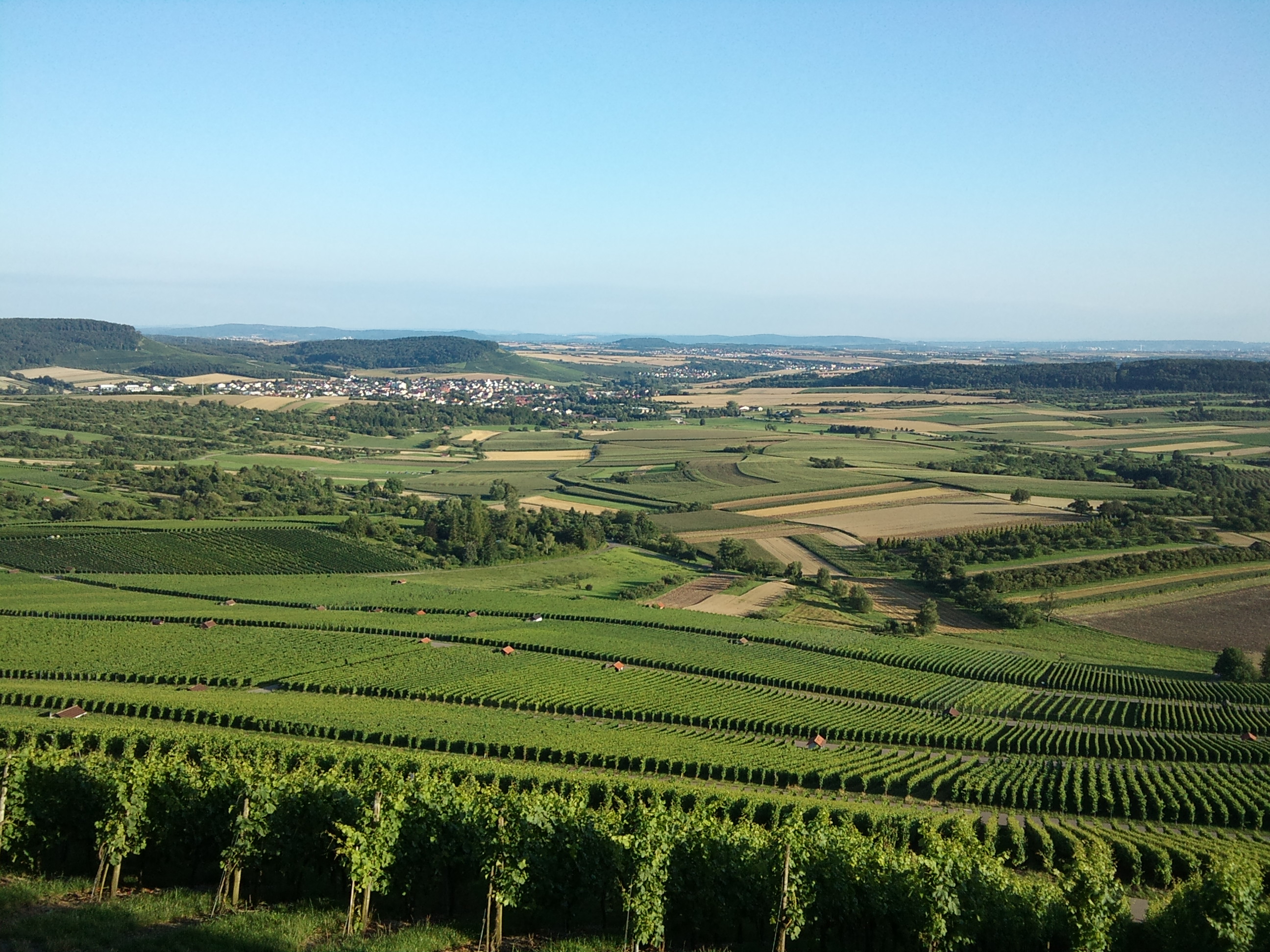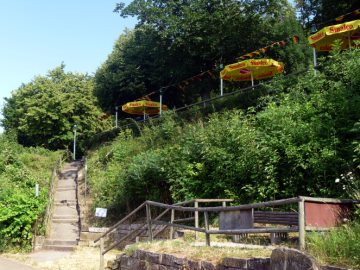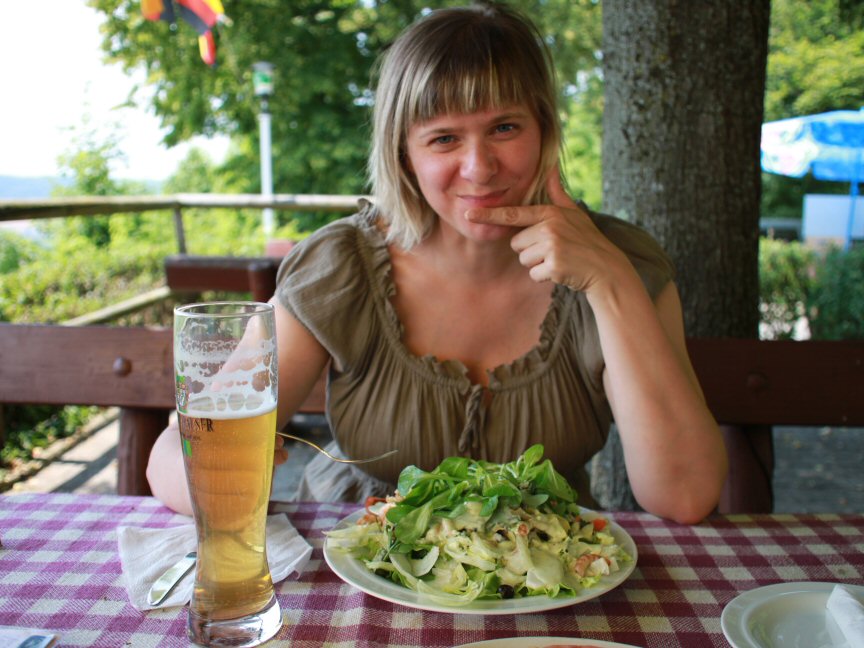Wunnenstein
View from the south
Geography
The Wunnenstein is in the area of the city Großbottwar, one kilometer northeast of the district wineries Hausen. A mile north is the Ilsfelder Abstetterhof district, about three kilometers east of the towns of Beilstein and Supreme field in Bottwartal.
The places referred to lie to about 250 m above sea level. NN and clearly dominated by Wunnenstein. The Wunnenstein making it a landmark that can be seen from many points in the space between Stuttgart and Heilbronn. It marks visible from afar a scenic and administrative boundary: south of Mount extends the district of Ludwigsburg, located in the Neckar basin, north of the mountain the lowlands with the district Heilbronn. The circular border is located just north of the Wunnensteins.
In the east, close to forest hill ( 376 m) and quiver mountain ( 323 m) two smaller mountains to. All three surveys are witnesses Keuper mountains of the highlands, the east of the Bottwartals rises in the form of the Löwenstein mountains. On the flat top of the hill, a protective blanket of quartz sandstone has received; it is just like the northern slopes forested. In contrast, cultivated on the Gipskeuper faces the south side of wine.
History
Because of its dominant position, the Wunnenstein was settled early. On the edge of the hilltop remains of a Celtic hill fort are preserved, and two kilometers west of the summit are to find more Celtic grave mounds in the forest beyond the A81. From Roman times, the existence of a Celtic- Roman temple could be detected by broken glass and brick finds.
After the conquest of the country by the Franks, a St. Michael's Church was built in the framework of Christian proselytizing, probably in the 8th or 9th century, built on the mountain. The church probably dates back to the Frankish royal court in the near Ilsfeld whose own church St. Michael's Church formed a joint parish. The church served as a sanctuary and parish church located below the hill winery community living. Through the Reformation in Württemberg, the church lost its function as a place of pilgrimage. Then winemakers Hausen 1556 got its own church within the town, and on command Duke Christoph, the church was demolished on the mountain. Only the tower remained standing because the area was used before the church until the 18th century as the cemetery of the church and the bell located in it for the death knell needed. After the abandonment of the cemetery fell into the tower. To the bell, called " Anna Susanna " is a myth, according to their sound kept the inhabitants of the area during severe weather off evil entwined. When the Heilbronner should have so she bought for her Kilian Church, she refused to beat down and was brought back.
On the eastern part of the summit plateau was a castle, which was probably built later than the 13th century and fell into disrepair in the 15th century in medieval times. Clearly visible is still the moat that divides the summit plateau. The seated there Lords of Wunnenstein were probably kinsmen of Ilsfelder local nobility. The best-known lord of the castle was Wolf of Wunnenstein, called the " Glimmering Wolf". He became known for his participation in numerous feuds in which he Graf Eberhard II of Württemberg times fought, sometimes supported, including at the Battle of Döffingen.
At the outbreak of the Peasants' War in 1525, a meeting of the insurgents took place on the Wunnenstein. On Easter Sunday, attracted two hundred citizens of the city Großbottwar on the nearby mountain and chose from among their ranks the host Matern Feuerbacher their leader. The farmer pile enlarged by inflow from other regions to over 8,000 men, and then journeyed to Stuttgart before he was destroyed in the Battle of Böblingen.
In the 19th century the Wunnenstein became a focal point of patriotic enthusiasm in Württemberg. The trigger was not last poems Ludwig Uhland, in which the deeds of the " glaring wolf " were glorified. The mountain became a popular destination, so that in 1819 a Wunnensteinführer appeared. 1847 a first viewing platform was built on the mountain. 1887 was distended at a fundraiser for the 100th anniversary of Ludwig Uhland money for a stone observation tower, which was then inaugurated in 1888 to mark the 500th anniversary of the Battle of Döffingen. This was built on the foundations of the ruined church tower, and when it was built medieval stone blocks were used, which are probably from the remains of the castle or the church. 1937, the lookout tower was increased by a wooden structure again and got a new bell.
Current use and conservation
Nationally known the Wunnenstein is mainly due to the two buildings that are now located on the mountain, the observation tower and located slightly below this mountain restaurant. The latter can be reached, including the parking lot through a branch of the county road that leads between winemakers Hausen and Abstetterhof over the saddle on the western edge of the mountain.
From the tower, the view stretches to the south and west over the whole district of Ludwigsburg and Stuttgart, in good weather to the Black Forest and the Swabian Alb. In the north of the district of Heilbronn is in sight, but mainly the mountains of the Odenwald. In the east, the view from the nearby Löwenstein Mountains is limited. The key to the tower is preserved in the mountain restaurant.
While the hilltop and the northern slopes are covered with mixed forest, the entire south-facing slope is wine country. After Wunnenstein the major site in the wine-growing area Württembergisch sub country is named, which includes all documents in the field of Bottwartals. On the mountain itself informed a 3 km long wine trail on many topics in viticulture, including the different varieties, the production processes and the history of viticulture.
The area around the Wunnenstein and the adjacent elevations was provided in 1989 a large area under conservation. The protected landscape area Wunnenstein, Forstberg and quiver mountain comprises a total of 533 ha
The A81 passes through the mountain in less than 2 km away. A motorway service station at Abstetterhof was christened Wunnenstein.










